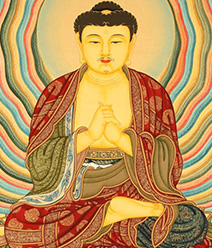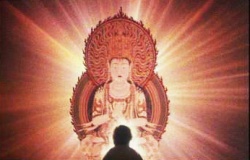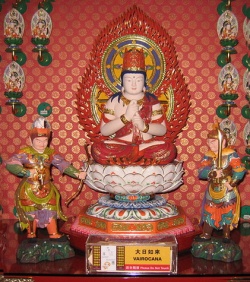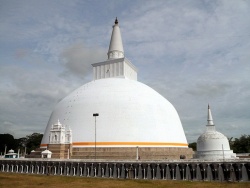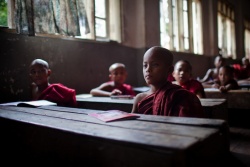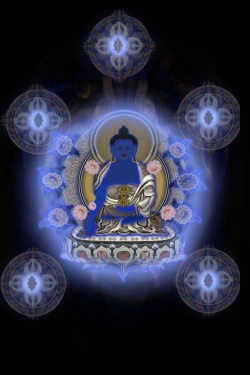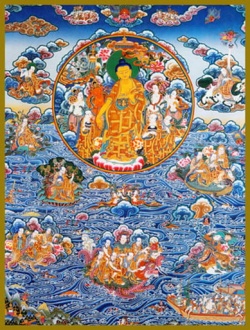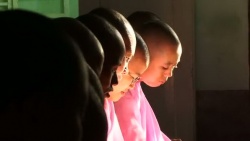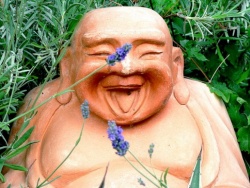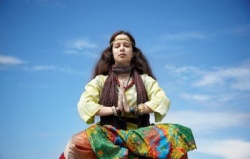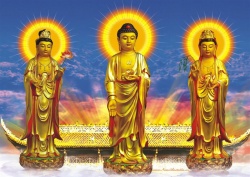Dhyani Buddha
Dhyāni-Buddha is a Sanskrit compound term from dhyāni ("contemplative, one who meditates") and Buddha (an "awakened one" or "the enlightened one"), which could be translated as "Buddha of Contemplation" . Celestial Buddhas
In Vajrayana Buddhism, there are five Dhyani-Buddhas, namely Akṣobhya, Amitābha, Amoghasiddhi, Ratnasaṃbhava, and Vairocana.
(Sanskrit) "Meditation Buddha."
Any one of the five symbolic aspects of the Buddha, often presented as "enlightened families" of Buddhas and Bodhisattvas.
These five Buddha families symbolize the fully developed consciousness related to the purified skandhas.
(Skt. pañcabuddha, Jpn. gobutsu 五佛)
Dhyani-Bodhisattva (and Dhyani-Buddha) (Dhyāni-Bodhisattva and Dhyāni-Buddha )
Bodhisattva and Buddha "of meditation"; a Bodhisattva or Buddha, such as Amitabha (Amida in Japanese), who appears to the eye of contemplative vision, but is not accessible in a historical form.
The five Dhyani-Buddhas or celestial buddhas are based on the Yogācāra teachings concerning the Trikaya (Sanskrit Tri: "three", and kaya: "body") doctrine, which posits three "bodies" of the Buddha.
The Dhyani-Buddhas are all aspects of the dharmakaya or "truth-body", which embodies the principle of enlightenment.
Dhyani-Buddha, in Mahayana Buddhism, and particularly in Vajrayana (Tantric) Buddhism, any of a group of five self-born celestial buddhas who have always existed from the beginning of time. The five are usually identified as Vairochana, Akshobhya, Ratnasambhava, Amitabha, and Amoghasiddhi.
In the esoteric, and even exoteric Buddhism of the North, Adi Buddha (Chogi dangpoi sangye), the One unknown, without beginning or end, emits a bright ray from its darkness.
This is the (the first), or Vajradhara, the Supreme Buddha (also called Dorjechang). As the Lord of all Mysteries he cannot manifest, but sends into the world of manifestation his heart—the “diamond heart,” Vajrasattva (Dorjesempa).
This is the second logos of creation, from whom emanate the seven (in the exoteric blind the five) Dhyani Buddhas, called the Anupadaka, “the parentless.”
These Buddhas are the primeval monads from the world of incorporeal being, the Arupa world, wherein the Intelligences (on that plane only) have neither shape nor name, in the exoteric system, but have their distinct seven names in esoteric philosophy.
The former Dhyāni-Buddhas only are called Anupadaka, parentless, because they radiated directly from that which is neither Father nor Mother but the unmanifested Logos.
Scholars in recent years have pointed out that the term Dhyani-Buddha does not appear in the original texts, but the nomenclature continues to be commonly used, particularly in describing groups of images composed of five meditating buddhas—as in mandalas (ritual meditation designs), on the four sides and top of votive stupas (commemorative monuments), or on the terraces of the great monument at Borobudur in Indonesia.
The five are almost identically represented in art, all dressed in monastic garments, seated with folded legs, with the same hairdress and long-lobed ears, but are distinguished by characteristic colours, symbols, poses of hands, and the directions they face.
The five eternal Buddhas are correlated to other groups of five, so that the entire cosmos is seen as divided between them and as emanating from them. Thus, each represents one of the five skandhas, or mental and physical aggregates that make up the whole of cosmic as well as individual existence.
According to the full exposition of this scheme, most of the other deities in the vast Buddhist pantheon are related to one of the five buddhas as members of his “family”;
reflect his distinguishing characteristics, such as colour, direction, and symbol; and when represented in art often carry an image of the “parent” buddha in their crown.
Each of the “self-born buddhas is also said to have manifested himself as an earthly buddha and as a bodhisattva (buddha-to-be).
Each has his own consort, mount, sacred syllable, natural element, particular sense organ, special sense perception, and symbolic location in the human body.
In order to counter any tendency toward polytheism suggested by the fivefold scheme, some sects elevated one of the five, usually Vairochana, to a position of an Adi-Buddha (first, or primal, buddha).
Sometimes a sixth deity is worshiped as the Adi-Buddha. Tibetan Buddhists identify the Adi-Buddha as Vajradhara; some Buddhist sects of Nepal give this position to Vajrasattva. The Five Dhyani Buddhas (Tibetan: Gyalwa Rig.Nga)
The five Dhyani buddhas represent the basic mandala in ourselves, our environment and in the cosmos.
They represent the five basic types of human personality, and demonstrate the absolutely perfected form of these personality types.
Most importantly, each of them represents a negative quality as well as the completely transformed aspect of that failing, manifested as a glorious wisdom. It is an ample demonstration of the genius of Vajrayana Buddhism that these weaknesses are not denied or suppressed.
They are instead worked upon, until their illusory nature is understood and they become aspects of one’s inherent wisdom.
All other deities belong to one of these buddha families. Through their tantric practice negative energies and attitudes are transformed into enlightened wisdoms.
The white Buddha Vairocana transforms ignorance and stupidity
The blue Buddha Aksobhya transforms violent anger
The yellow Buddha Ratnasambhava transforms pride
The red Buddha Amitabha transforms passion
The green Budda Amoghasiddhi transforms jealousy
Vairochana (Tibetan: Namnang), The King
In the Rigveda the word ‘vairochana’ has the connotation of a brilliant and luminous sun. Indeed, Vairochana in Tibetan is called Namnang, meaning ‘The illuminator.’
He is an emanation of Adibuddha and represents the cosmic element of form (rupa).
He is the primordial wisdom of the sphere of reality. His is in the center of the mandala consisting of the five Transcendental Buddhas, and his rites pacify negative emotions.
He is white and his two hands are held against the chest with his thumbs and forefingers touching. Vairochana displays the Dharmachakra mudra. Dharmachakra in Sanskrit means the ‘Wheel of Dharma’.
This mudra symbolizes one of the most important moments in the historical life of the Buddha, the occasion when he preached to his companions the first sermon after his Enlightenment in the Deer Park at Sarnath.
It thus denotes the setting into motion of the Wheel of the teaching of the Dharma.
Vairochana is an idealization of this central function of the Buddha as a teacher, without which there would have been no Buddhism, and no path to enlightenment open before us.
Meditating on the image of Vairochana is specifically believed to transform the delusion of ignorance into the wisdom preached by the Dharma. When Gautama Buddha turned the wheel of the Dharma, it illuminated (like a sun), the hearts of men and women darkened by ignorance.
Significantly, Vairochana is said to be the sum of all the Dhyani Buddhas and combines all their qualities. He is therefore, pure white, since white is a blend of all colors. He radiates the light of Buddhahood and his consort is Akashadhateshvari, who is the sovereign lady of infinite space.
So the dance of light and the space for it to radiate through creates the united dance of Dharmadhatu. It is this dance that is represented by these unions and the sexual imagery depicted in Tantra.
Akshobya (Tibetan: Mikyopa), The Mirror to Our Souls
Akshobya is the second of the Transcendental Buddhas.
He originates from the blue seed syllable HUM and represents the primordial cosmic element of consciousness;
immutable and imperturbable. The path to enlightenment through the Vajra family is one of breaking free of constraints and obstacles, transmuting negativity, and is generally more dynamic and proactive.
Akshobhya’s blue color is closely linked to the mirror symbolism. Blue is the color of water, and water has the capacity to act as a clear mirror. Akshobhya is believed to transform the human failing of anger into a clear mirror-like wisdom.
With this wisdom, we see things just as they are, impartially and unaffectedly. Indeed, whether it be a red rose or a bloody dagger, a mirror will reflect both just as they are.
It will not be judgmental and distinguish between the two reds, attempting to hold to the first and flee from the second. No reflection in a mirror sticks to it, and none repels it. The mirror always stands imperturbable and immutable, just as we should, whether the circumstances be favorable or unfavorable to us.
He sits in the earth touching mudra with his left hand resting on his lap face up and his right hand resting on the right knee with the tip of the middle finger touching the earth with palm drawn inwardly as he faces the East.
The Bhumisparsha mudra (earth touching gesture) recalls the incident just before Buddha’s enlightenment when he was challenged by Mara, the personification of evil. Mara was convinced that the spiritual throne where Buddha was sitting belonged rightly to him.
Accordingly he challenged Buddha to prove his claim to the seat. Buddha moved his hand to touch the ground with his fingertips, and thus bid the goddess Earth to bear witness to his right to be sitting where he was. She did so with a hundred thousand roars, and validated Buddha’s assertion.
Akshobhya is considered the ruler over the eastern direction. It is the direction where dawn takes place. Indeed, Buddha’s victory over Mara heralded the dawning of a new, spiritual reality. He is often depicted with his consort Lochana who expresses the mirror-like primordial wisdom.
Ratnasambhava (Tibetan: Gyalwa Rinjun), The Gem of Buddha Ratnasambhava is the third of the five Transcendental Buddhas. Ratnasambhava means ‘Born from the Jewel,’ ‘ratna’ signifying jewel in Sanskrit.
Ratnasambhava is believed to transform the negative human trait of pride into the wisdom of sameness. His wisdom is associated with experience and known as representing the “primordial wisdom of equality.
He is associated with the human realm on the wheel of life. He is known for his equanimity reminding us that all human beings are precious.
This wisdom brings out the common features of human experience and makes us see the common humanity underlying all men and women. It makes us see ourselves as fellow-beings, organically united to the total stream of humanity.
In this state of enlightenment, there is nobody superior or inferior to the other, leaving no scope for pride to develop.
Ratnasambhava’s color is yellow. This is the color of the earth. The earth too is extremely generous in sharing with us her riches. Also she gives without any expectation or favor in return. She gives and also receives all equally.
The earth is thus the great leveler. Similarly, Ratnasambhava’s radiance dissolves all boundaries of self and the other.
We can then just share with others – without any associated sense of giving, because giving requires a ‘self’ to give and ‘others’ to receive, a duality which Ratnasambhava helps us transcend.
Ratnasambhava displays the Varada mudra. This mudra symbolizes charity and boon granting.
Indeed his distinct emblem is a jewel (ratna), associating him with riches and Ratnasambhava is sometimes described as the Buddha of giving. But he makes no distinction and gives freely to all (the wisdom of sameness).
All beings are equally precious to him. Whatever our social position, race, sex, or life form, we are all made from a common clay. The grace of Ratnasambhava shines equally on the palace and dung heap. Meditating on his wisdom we develop solidarity with all humanity, nay with all forms of life.
Ratnasambhava guards over the direction south. The sun is in the south at noon-time. Its rays are then a light-golden-yellow, the hue of Ratnasambhava himself. Thus he faces the south in with his consort Mamaki.
Amitaba (Tibetan: Opame), The Gentle and Lovable Buddha, the Buddha of Infinite Light
Amitaba is the fourth and most ancient of the five Transcendental Buddhas that embody the five primordial wisdoms meditation.
He presides over the Buddha realm Sukavati (Tibetan: Dewachen), a Pure Land which is the expression of his own field of pure expression and nothing else.
Amitaba is the Lord of the Padma or Lotus family and is the pure expression of the wisdom of discriminating awareness, which transmutes the poison of attachment and desire.
He and the other Lotus family members support the gradual unfolding of one’s spiritual petals into enlightenment.
Amitaba is red in color, sits in the full-lotus posture with his two hands resting on his lap in the mudra of meditative equipoise.
According to tradition, this mudra derives from the one assumed by the Buddha when he was meditating under the pipal tree, in the pursuit of Nirvana. In conformity with his hand mudra, the essential message of Amitabha is that of meditation.
His association with the setting sun suggests the withdrawal of our external sense perceptions inwards, into higher states of meditative concentration.
Elevating ourselves to such a spiritual level has the ultimate objective of uniting us with that intangible Universal Consciousness which pervades all tangible reality.
Amitabha is most often depicted in thangkas flanked by two eminent bodhisattvas, Avalokitesvara, the Bodhisattva of Compassion and Vajrapani, the Bodhisattva of Power.
It is the special vow of Amitabha that to benefit beings who are caught in the realm of their own confusion and suffering, that if they remember his name with faith at the time of their death they will take rebirth in Sukhavati.
Through this they will achieve enlightenment and not again fall into a realm of suffering. This is due to the power of the merit of Buddha Amitabha’s virtuous activities accumulated throughout his countless lives as a bodhisattva.
Because of this, meditation upon Amitabha is widespread and very popular.
His direction is the west. It is in this direction that sunset takes place, and he is envisioned as the setting sun (red). During sunset, the sun is gentle, and we can directly look into its fierce power, without coming to any harm.
As it disappears into the west, the sun is like a proud and fierce king, who at the end of a hard day of rigid protocol turns gentle and jovial, and allows anyone to approach him. Amitabha is thus the supreme power and energy of nature, cast on an earthly plain, accessible to all of us.
In some mandalas, Amitabha is depicted in union with his Wisdom Consort Gokarmo, who embodies the pure element of fire.
Amitayus (Tibetan: Tsepagme) Buddha of Limitless Life
Amitayus is the reflexive form of Amitaba and is the embodiment of infinite life and therefore the focus of the life practices that remove the possibility of untimely or premature death. He brings about a healing of sicknesses, degeneration and imbalances in the five elements of the body due to karma, excess and unclean living. He is known as the Buddha of long life.
He is often red but sometimes white in color. His two hands rest in his lap in the mudra of equanimity with the palms facing each other holding the Vase of Life, that is filled with the nectar of immortality.
It is only in the Tantric Buddhism of Tibet and Japan that Amitayus and Amitaba are considered different deities.
Amogasiddhi (Tibetan: Donyo Drupa), The Lord of Karma, Buddha of Unfailing Accomplishment)]
The Buddha Amogasiddhi is the fifth of the Transcendental Buddhas that embody the five primordial wisdoms. Amoghasiddhi is particularly associated with energy and is known as the Lord of Karma.
As a Buddha of action, he represents the practical achievement of results using the wisdom of the other four Buddhas. His double vajra too is a symbol of the successive conclusion of all actions. He embodies the wisdom of all-accomplished activity that transmutes the poison of jealousy.
Amoghasiddhi is believed to alter the negative human failing of jealousy into the positive wisdom of accomplishment. Jealousy is a positive human emotion in as much that it fuels our ambition and prompts us to achieve greater heights. But its negativeness stems from the fact that it is almost always accompanied by a bitterness towards the one who is the target of our envy.
His recognition symbol is the double dorje (visvavajra), representing his wisdom of all-accomplishing activity. His attributes are power and energy that is both subtle and often hidden.
Amogasiddhi is the Supreme Siddhi—the magic power of enlightenment. In this way the inner and outer world, and the visible and invisible are united as the body becomes spirit and the spirit embodies.
His body is green, the color of the peace and tranquility of Nature. It is a soothing and relaxing color, which calms anxiety. His left hand rests in his lap in the mudra of equipoise and his right hand is held at chest level facing outwards in the mudra of granting protection.
The hand mudra made by Amoghasiddhi is the Abhaya mudra. Abhaya in Sanskrit means fearlessness. Thus this mudra symbolizes protection, peace, and the dispelling of fear.
According to the Buddhist tradition, Buddha’s cousin Devadatta felt greatly jealous of him. His jealousy knowing no bounds, he once even attempted to murder the Buddha. His plan involved loosing a rampaging elephant into the Buddha’s path.
But as the elephant approached him, Buddha displayed the Abhaya mudra, which immediately calmed the animal. Accordingly, it indicates not only the appeasement of the senses, but also the absence of fear.
He is often depicted in union with is Wisdom Consort Damtsig Drolma, Green Tara, who embodies the pure element of air. The deity Green Tara is believed to have emanated from Amoghasiddhi. She is always depicted in a posture with her right leg extended, signifying her readiness to spring into action.
